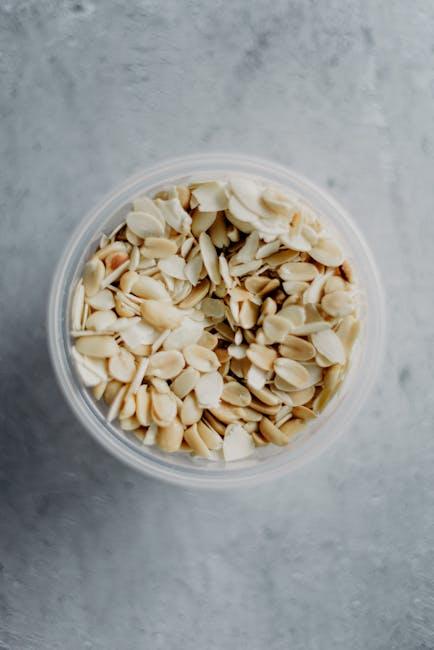Creating a calorie-conscious meal plan is a powerful step toward achieving your fat loss goals, combining mindful eating with nutritional knowledge to foster sustainable weight management. In today’s fast-paced world, where food choices are abundant and often overwhelming, understanding how to craft a meal plan that supports fat loss without sacrificing flavor or satisfaction is essential. This guide will walk you through the principles of calorie awareness, helping you make informed choices that align with your health objectives. With confidence and clarity, we will explore practical strategies for building meals that not only satisfy your hunger but also support your journey toward a leaner, healthier you. Whether you’re new to meal planning or looking to refine your approach, this article will equip you with the tools you need to succeed.
Understanding Your Caloric Needs for Effective Fat Loss
Understanding your body’s caloric needs is pivotal in crafting a meal plan that aids in shedding excess fat. To determine your daily calorie requirement, it’s essential to first calculate your Basal Metabolic Rate (BMR) and then adjust for activity level using the Total Daily Energy Expenditure (TDEE). BMR represents the number of calories your body needs at rest to maintain vital functions, while TDEE accounts for calories burned through daily activities and exercise. A caloric deficit, achieved by consuming fewer calories than your TDEE, is crucial for effective fat loss. However, it’s important to ensure this deficit isn’t too extreme, as this can lead to muscle loss and nutritional deficiencies.
- Calculate Your BMR: Use a reliable online calculator or the Harris-Benedict equation to estimate your BMR.
- Determine Your TDEE: Multiply your BMR by an activity factor that reflects your lifestyle.
- Establish a Caloric Deficit: Aim for a deficit of 500-1000 calories per day for a safe and sustainable fat loss of 1-2 pounds per week.
- Monitor and Adjust: Regularly track your progress and make necessary adjustments to your caloric intake and activity level.
By understanding these key components, you can create a meal plan that not only supports fat loss but also nourishes your body with essential nutrients, ensuring you feel energized and satisfied throughout your journey.

Choosing Nutrient-Dense Foods to Fuel Your Body
When constructing a calorie-conscious meal plan aimed at promoting fat loss, selecting foods that are rich in nutrients yet low in calories is key. These foods help ensure that you are getting the vitamins, minerals, and other essential nutrients your body needs, while also keeping your calorie intake in check. Opt for whole, unprocessed foods that are naturally filling and support your body’s metabolic processes.
- Leafy Greens: Spinach, kale, and Swiss chard are excellent choices, packed with fiber, vitamins, and minerals, yet very low in calories.
- Lean Proteins: Chicken breast, turkey, and tofu provide the protein necessary for muscle repair and growth, which is crucial for maintaining a healthy metabolism.
- Whole Grains: Quinoa, brown rice, and oats offer complex carbohydrates and fiber, helping to sustain energy levels and promote satiety.
- Fruits: Berries, apples, and oranges are nutrient powerhouses with antioxidants and vitamins, perfect for a sweet treat that won’t derail your calorie goals.
- Healthy Fats: Avocados, nuts, and olive oil provide essential fatty acids and help you feel full longer, making them a smart addition to your meals.
Incorporating these nutrient-dense foods into your diet not only supports fat loss but also enhances overall health, making it easier to achieve and maintain your fitness goals.
Balancing Macronutrients for Optimal Energy and Satiety
To construct a meal plan that supports fat loss while ensuring you feel energized and satisfied, it’s crucial to pay attention to the distribution of macronutrients: proteins, carbohydrates, and fats. Each macronutrient plays a vital role in your body’s functioning and affects your hunger levels differently. Here’s how you can balance them effectively:
- Proteins: Aim for a substantial portion of your meals to come from lean proteins. Options like chicken breast, tofu, and legumes not only help repair and build muscle but also keep you feeling full longer.
- Carbohydrates: Choose complex carbohydrates, such as quinoa, brown rice, and sweet potatoes, which provide sustained energy without causing spikes in blood sugar levels.
- Fats: Incorporate healthy fats like avocados, nuts, and olive oil. These fats are crucial for hormone regulation and can enhance the flavor and satiety of your meals.
Striking the right balance means personalizing the ratio of these macronutrients based on your specific needs and goals. A common approach is to allocate approximately 40% of your daily calories to carbohydrates, 30% to proteins, and 30% to fats, but individual requirements may vary. Experiment and adjust to find what keeps you feeling your best while steadily progressing towards your fat loss goals.
Creating a Flexible Meal Schedule to Support Your Goals
Designing a meal schedule that adapts to your lifestyle while aligning with your fat loss objectives is crucial. Begin by identifying your daily caloric needs, considering factors such as your activity level and metabolic rate. With these insights, create a flexible plan that allows for adjustments without compromising your goals. Flexibility is key; life is unpredictable, and a rigid meal schedule can lead to unnecessary stress and setbacks.
Incorporate the following elements to enhance your meal plan’s adaptability:
- Balanced Macronutrients: Ensure each meal contains a healthy mix of proteins, fats, and carbohydrates.
- Meal Timing: Experiment with meal timing to find what works best for your body and schedule.
- Portion Control: Use portion control techniques to prevent overeating and maintain caloric deficits.
- Healthy Snacking: Keep nutritious snacks on hand for moments when hunger strikes between meals.
By integrating these strategies, you’ll be able to maintain a diet that is both sustainable and effective in promoting fat loss.
